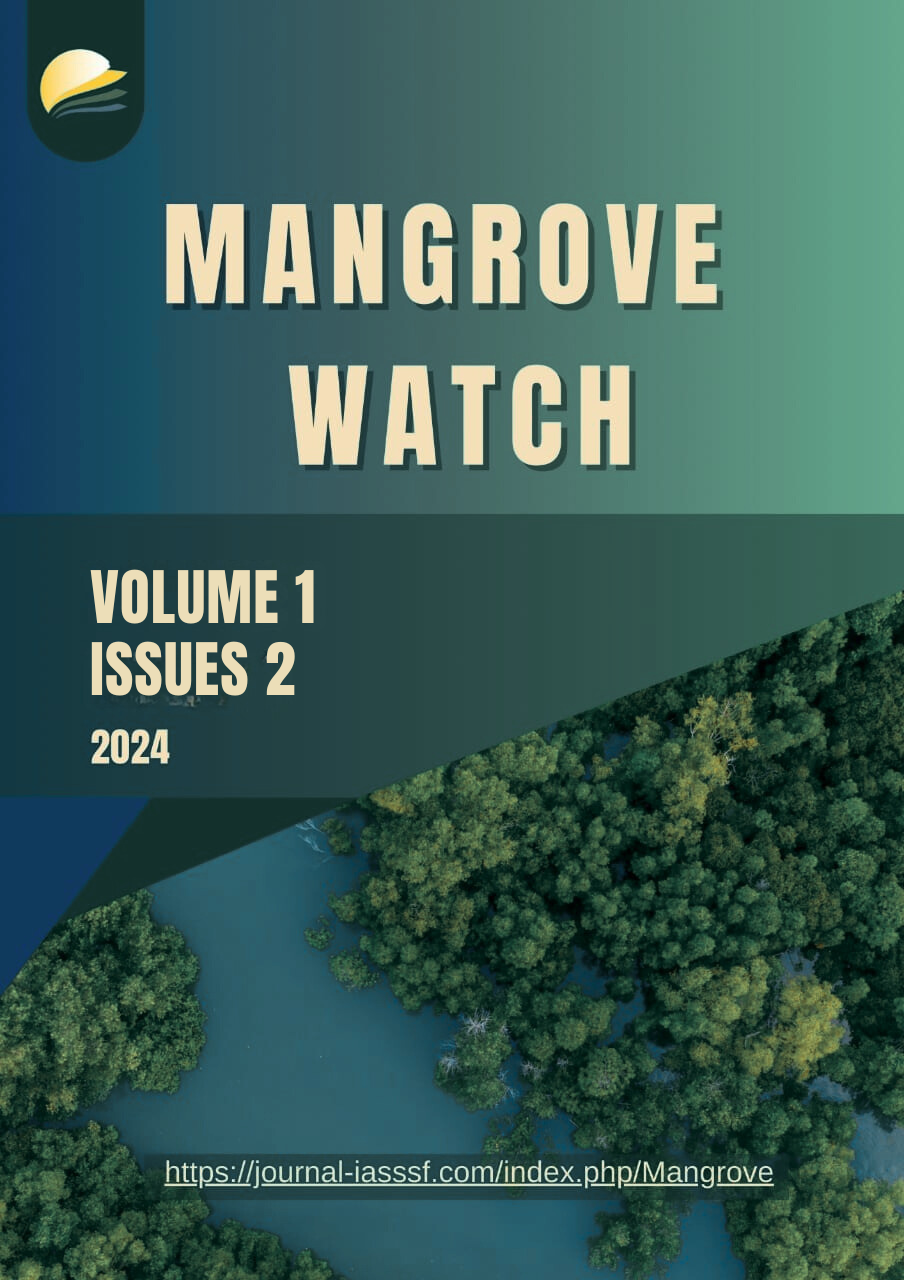Impacts of land clearing for oil palm on coastal ecosystems: A case study of forest and land fires in Riau Province, Indonesia
DOI:
https://doi.org/10.61511/mangrove.v1i2.2024.924Keywords:
environmental economics, forest and land fires, ISPO/RSPO certification, land burning, palm oil, RiauAbstract
Background: Forest and land fires (KARHUTLA) on tropical peatlands in Riau Province, Indonesia, are a recurring environmental crisis linked to the expansion of oil palm plantations. Despite regulatory frameworks, the use of fire for land clearing persists, driven by economic incentives and weak enforcement. This study investigates the environmental, economic, and social impacts of land burning in Riau, focusing on plantation expansion, illegal operations, and regulatory loopholes. Methods: A qualitative-descriptive approach was employed, supported by secondary data analysis from governmental and institutional reports. The study utilizes an environmental-economic framework to assess the interdependence between natural resource exploitation and macroeconomic indicators, including the Environmental Kuznets Curve (EKC) and IPAT model. Findings: Oil palm plantations in Riau increased by 120,000 hectares, with approximately 1.8 million hectares operated illegally by 190 companies. This expansion significantly contributes to karhutla, resulting in health issues, haze, and transboundary pollution. Although palm oil exports support Riau’s economic growth—accounting for half of its total exports in 2021—this comes at the cost of severe environmental degradation and tax losses of up to IDR 150 trillion. Regulatory exceptions permitting traditional burning practices are frequently exploited, undermining enforcement efforts. Conclusion: This paper concludes that sustainable solutions require tighter regulation, stronger institutional enforcement, mandatory ISPO/RSPO certification, and a shift toward technological innovations in land clearing. Furthermore, fiscal policies such as commodity taxation can fund environmental restoration efforts. Novelty/Originality of this Article: This study lies in its integrated analysis of ecological degradation and economic output through a macroeconomic lens, offering actionable recommendations for balancing palm oil-driven economic growth with environmental sustainability in developing regions.
References
Alen, V. P. L., Hidayat, A., & Rizki, K. (2021). upaya presiden Joko Widodo dalam menghadapi penolakan ekspor komoditas CPO (Crude Palm Oil) oleh Uni Eropa Tahun 2017-2020. IJGD: Indonesian Journal of Global Discourse, 3(1), 110-131. https://doi.org/10.29303/ijgd.v3i1.28
Badan Pusat Statistika Provinsi Riau. (2022). Statistik Kelapa Sawit Riau tahun 2021. https://riau.bps.go.id/id/publication/2024/01/22/ceb97f2ba19041360c6279f5/statistik-kelapa-sawit-provinsi-riau-2022.html
Common, M., & Stagl, S. (2005). Ecological Economics. Cambridge University Press. https://doi.org/10.1017/CBO9780511805547
de Morais, J. C. M. (2013). Fighting forest fires in Brazil. In In: González-Cabán, Armando, tech. coord. Proceedings of the fourth international symposium on fire economics, planning, and policy: climate change and wildfires. Gen. Tech. Rep. PSW-GTR-245 (English). Albany, CA: US Department of Agriculture, Forest Service, Pacific Southwest Research Station: 179-190 (Vol. 245, pp. 179-190). https://research.fs.usda.gov/treesearch/44508
Dhandapani, S., & Evers, S. (2020). Science of the total environment oil palm ‘ slash-and-burn ’ practice increases post- fi re greenhouse gas emissions and nutrient concentrations in burnt regions of an agricultural tropical peatland. Science of the Total Environment, 742, 140648. https://doi.org/10.1016/j.scitotenv.2020.140648
DPR RI. (2022). DPR Beri Catatan Penyelesaian Penertiban Kebun Sawit Ilegal di Riau. Buletin Parlementaria, 1–24. https://berkas.dpr.go.id/pemberitaan/buletin-parlementaria/b-1189-3-2022.pdf
Escobar, H. (2019). There’s no doubt that Brazil’s fires are linked to deforestation, scientists say. Science, 365, 853. https://doi.org/10.1126/science.365.6456.853
Evers, S., Yule, C. M., Padfield, R., O'Reilly, P., & Varkkey, H. (2017). Keep wetlands wet: the myth of sustainable development of tropical peatlands–implications for policies and management. Global Change Biology, 23(2), 534-549. https://doi.org/10.1111/gcb.13422
Kementrian Perdagangan Republik Indonesia. (2023). Periode 16–30 Juni 2023, Harga referensi CPO turun, bea Keluar CPO USD 3/MT, pungutan ekspor CPO USD 65/MT. https://www.kemendag.go.id
Kitab Undang-Undang Hukum Pidana Pasal 187 Pengaturan Delik Menyebabkan Kebakaran, Peletusan, atau Banjir. https://www.hukumonline.com/klinik/a/pasal-187-kuhp-tentang-kejahatan-yang-membahayakan-keamanan-umum-lt673c88cd19760/
Oliphant, E., & Simon, A. C. (2022). The cost of sustainable palm oil: Should an Indonesian smallholder pursue RSPO-certification?. World Development Perspectives, 26, 100432. https://doi.org/10.1016/j.wdp.2022.100432
Page, S. E., Siegert, F., Rieley, J. O., Boehm, H. D. V., Jaya, A., & Limin, S. (2002). The amount of carbon released from peat and forest fires in Indonesia during 1997. Nature, 420(6911), 61-65. https://doi.org/10.1038/nature01131
Peraturan Menteri Lingkungan Hidup Nomor 10 tahun 2010 tentang Pencegahan Kerusakan Lingkungan Hidup yang Berkaitan dengan Kebakaran Lahan. https://rfmrc-sea.org/wp-content/uploads/2017/11/Peraturan-Menteri-LH-No-10-Tahun-2010-Tentang-Mekanisme-Pencegahan-Pencemaran-dan-atau-Kerusakan-Lingkungan-Hidup-yang-Berkaitan-dengan-Kebakaran-Hutan-dan-atau-Lahan.pdf
Republika. (2023). Hingga Juli 2023, 990,59 lahan di Riau terbakar. https://news.republika.co.id/berita/ryrito370/hingga-juli-2023-99059-hektare-lahan-di-riau-terbakar
Sgqolana, T. (2021). Our Burning Planet. Daily Maverick. https://www.dailymaverick.co.za/article/2021-10-04-the-burning-season-wildfires-sweeping -across-south-africa-a nd-namibia-have-left-devastation-in-their-wake/
Strydom, S., & Savage, M. J. (2016). A spatio-temporal analysis of fires in South Africa. South African Journal of Science, 112(11-12), 1-8. https://doi.org/10.17159/sajs.2016/20150489
Susanti, A., & Maryudi, A. (2016). Forest Policy and Economics Development narratives , notions of forest crisis , and boom of oil palm plantations in Indonesia. Forest Policy and Economics, 73, 130–139. https://doi.org/10.1016/j.forpol.2016.09.009
Utami, P. N., & Primawardani, Y. (2021). Efforts to fulfill the right to the environment to forest fires for the people of Riau. Jurnal HAM, 12(3), 1–12. http://dx.doi.org/10.30641/ham.2021.12.367-384
Ziaei, S. M., & Ali, I. (2021). Commodity exports and macroeconomic performance: The case of palm oil in Malaysia. Cogent Economics & Finance, 9(1), 1901388. https://doi.org/10.1080/23322039.2021.1901388
Downloads
Published
Issue
Section
Citation Check
License
Copyright (c) 2024 Assyifa Fauzia

This work is licensed under a Creative Commons Attribution 4.0 International License.















